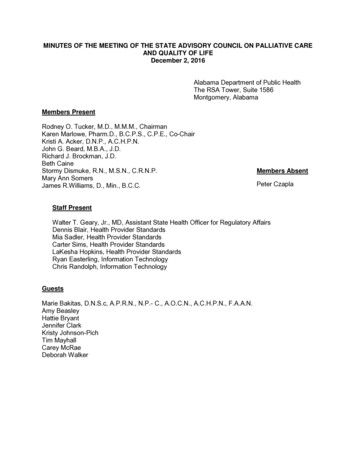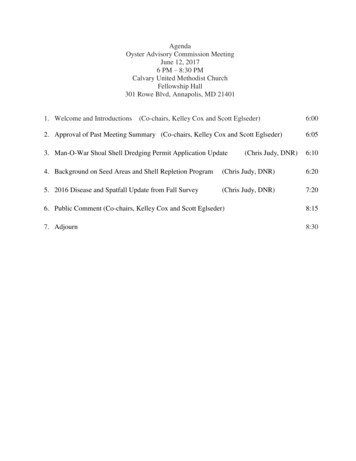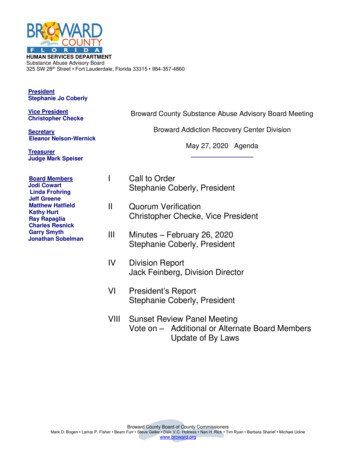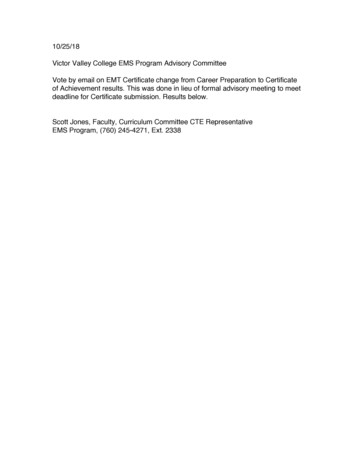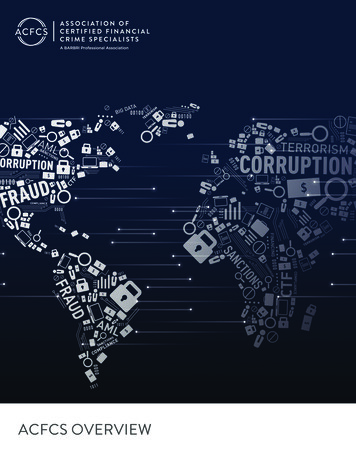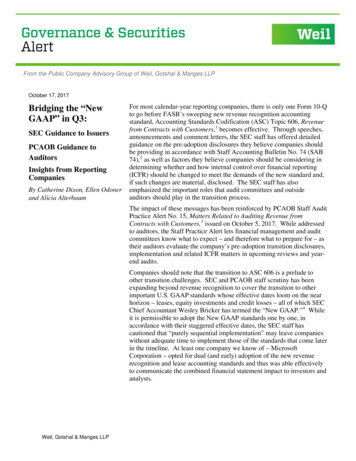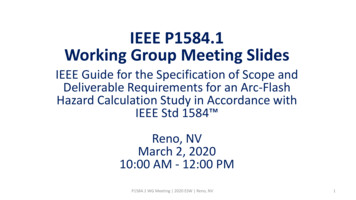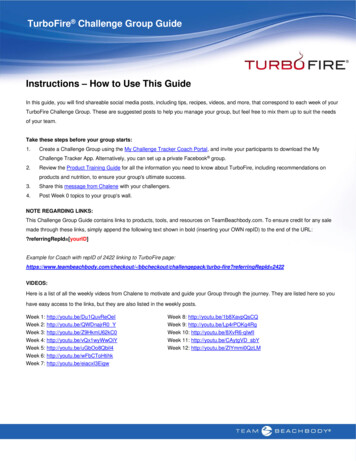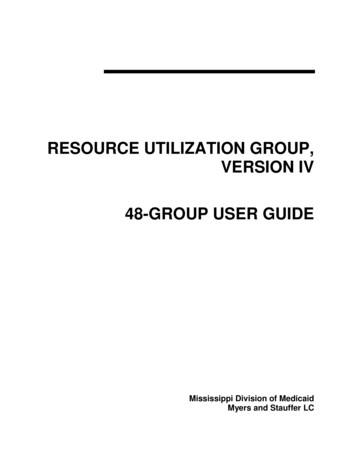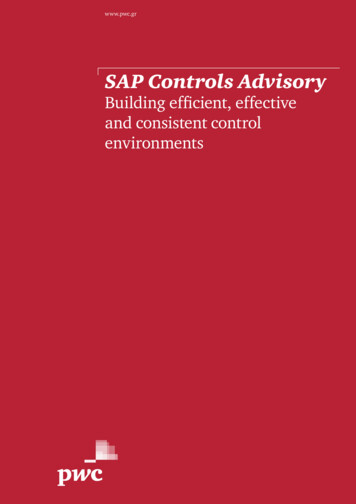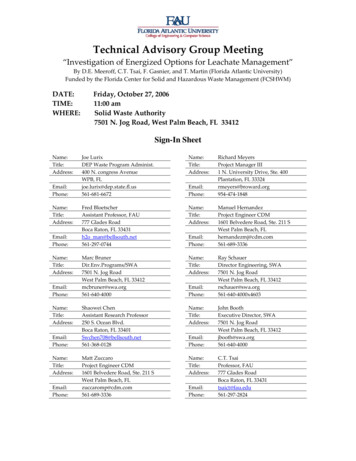
Transcription
Technical Advisory Group Meeting“Investigation of Energized Options for Leachate Management”By D.E. Meeroff, C.T. Tsai, F. Gasnier, and T. Martin (Florida Atlantic University)Funded by the Florida Center for Solid and Hazardous Waste Management (FCSHWM)DATE:TIME:WHERE:Friday, October 27, 200611:00 amSolid Waste Authority7501 N. Jog Road, West Palm Beach, FL 33412Sign-In ail:Phone:Joe LurixDEP Waste Program Administ.400 N. congress AvenueWPB, tle:Address:Fred BloetscherAssistant Professor, FAU777 Glades RoadBoca Raton, FL 33431h2o s:Marc BrunerDir.Env.Programs/SWA7501 N. Jog RoadWest Palm Beach, FL dress:Shaowei ChenAssistant Research Professor250 S. Ocean Blvd.Boca Raton, FL itle:Address:Matt ZuccaroProject Engineer CDM1601 Belvedere Road, Ste. 211 SWest Palm Beach, e:Email:Phone:Richard MeyersProject Manager III1 N. University Drive, Ste. 400Plantation, FL 33324rmeyers@broward.org954‐474‐1848Manuel HernandezProject Engineer CDM1601 Belvedere Road, Ste. 211 SWest Palm Beach, FLhernandezmj@cdm.com561‐689‐3336Ray SchauerDirector Engineering, SWA7501 N. Jog RoadWest Palm Beach, FL 33412rschauer@swa.org561‐640‐4000x4603John BoothExecutive Director, SWA7501 N. Jog RoadWest Palm Beach, FL 33412jbooth@swa.org561‐640‐4000C.T. TsaiProfessor, FAU777 Glades RoadBoca Raton, FL 33431tsaict@fau.edu561‐297‐2824
Minutes1.Opening Address (11:15 PM) by Dr. Meeroff followed by introduction of the group membersand participants2.Introduction of Landfill Leachate Project by Dr. Meeroff- Objectives- Overview3.Discussion of Study Methodology by François Gasnier- Literature review- Landfill surveys- Evaluation of leachate quality data- Evaluation of management strategies- Discussion of Photochemical Iron‐Mediated Aeration (PIMA) laboratory experiments4.Discussion of Photocatalytic Nanoparticles by Dr. Shaowei Chen5.Discussion of Future Work by Dr. Meeroff- Summary of Energized Processes (in lay terms)- Management Model- Broader Impacts- Project Website- Acknowledgements6.Discussion of TAG Input Needs (Open Forum)‐ Previous Experiences‐ General Discussion‐ Dr. Bloetscher commented about upcoming reuse standards for permitting new deepwell injection systems‐ Marc Bruner commented about residuals generated in the process and the possibility ofneeded a TCLP analysis to determine if the residuals generated can be landfilled.‐ John Booth asked for several clarifications about the potential applications of these newtechnologies.‐ Joe Lurix volunteered to provide additional information concerning leachate volumesdischarged as well as information concerning management technologies and contacts forsolid waste management personnel not represented at this TAG meeting (i.e. Okeechobee,Medley, St. Lucie, Martin County)7.Adjourn (12:35 PM), thank you for participating
“Investigation of Energized OptionsFor Leachate Management”Presentation to the FCSHWM Technical Advisory GroupSolid Waste Authority of Palm Beach County, West Palm Beach, FL, October 27, 2006D.E. MEEROFF, Ph.D., E.I.Assistant Professor, Department of Civil Engineering, Florida Atlantic UniversityDirector, Laboratories for Engineered Environmental SolutionsC.T. Tsai, Ph.D., S. Chen, Ph.D.Professor, Department of Mechanical Engineering, Florida Atlantic UniversityF. GasnierMSCE, Florida Atlantic UniversityDaniel E. Meeroff, Ph.D. FCSHWM Technical Advisory Group Meeting, West Palm Beach, FL Oct. 27, 2006Agenda1.1. emarksDr. Meeroff2.2. PreliminaryPreliminaryResultsResultsF. esNanoparticlesDr. eryoneDaniel E. Meeroff, Ph.D. FCSHWM Technical Advisory Group Meeting, West Palm Beach, FL Oct. 27, 20061
Leachate IssuesColorElevatedTDS, BOD,NH3, VOCsHeavy metalsPb, As, Cd, HgpHHightoxicityCOD/BODratioOdorPathogens Leachate quality is highly variable Type of solid waste (MSW, Ash monofill, C&D) Maturity of landfillDaniel E. Meeroff, Ph.D. FCSHWM Technical Advisory Group Meeting, West Palm Beach, FL Oct. 27, 2006Rationale All-inclusive solutions are not currentlyavailable for leachate management Need for sustainable options to safelydischarge to the environment Futuristic energized processes developedfor detoxification of groundwater and soilsmay be the answer: Photochemical Iron-Mediated Aeration (PIMA) TiO2-magnetiteDaniel E. Meeroff, Ph.D. FCSHWM Technical Advisory Group Meeting, West Palm Beach, FL Oct. 27, 20062
Objectives of the ResearchObjectiveObjective 11EvaluateEvaluateAlternativesAlternatives Review & collectleachate qualitydata Identify trends Rank alternatives(performance, risk,environmental andeconomic factors)Year 1ObjectiveObjective 22EvaluateEvaluateEPsEPsObjectiveObjective 33DevelopDevelopManagementManagementToolTool Preliminary costanalysis Preliminary riskassessment Web-based BMPguide Interactive andgoal-based Technical data(with the goal ofachieving sewerdischarge limits ) PIMA TiO2-MagnetiteYear 2Daniel E. Meeroff, Ph.D. FCSHWM Technical Advisory Group Meeting, West Palm Beach, FL Oct. 27, 2006“Investigation of Energized OptionsFor Leachate Management”Presentation to the FCSHWM Technical Advisory GroupSolid Waste Authority of Palm Beach County, West Palm Beach, FL, October 27, 2006D.E. MEEROFF, Ph.D., E.I.Assistant Professor, Department of Civil Engineering, Florida Atlantic UniversityDirector, Laboratories for Engineered Environmental SolutionsC.T. Tsai, Ph.D., S. Chen, Ph.D.Professor, Department of Mechanical Engineering, Florida Atlantic UniversityF. GasnierMSCE, Florida Atlantic UniversityDaniel E. Meeroff, Ph.D. FCSHWM Technical Advisory Group Meeting, West Palm Beach, FL Oct. 27, 20063
Future Work1. Design TiO2-magnetite reactor2. Complete scoping tests on Pb, TDS,conductivity, ammonia, and COD3. Begin performance testing withmixtures & actual leachate from SWA4. Develop cost analyses and riskassessments for BMP guide5. Develop management toolDaniel E. Meeroff, Ph.D. FCSHWM Technical Advisory Group Meeting, West Palm Beach, FL Oct. 27, 2006Management eInteractiveGoal-basedUser Input niel E. Meeroff, Ph.D. FCSHWM Technical Advisory Group Meeting, West Palm Beach, FL Oct. 27, 20064
Benefits to the University Stimulate progressin technologies forreducing toxics Strengthen thecooperativerelationship betweenFAU and SWA Hands-on studenttraining in solidwaste managementDaniel E. Meeroff, Ph.D. FCSHWM Technical Advisory Group Meeting, West Palm Beach, FL Oct. 27, 2006Additional Support FAU College of Engineering and Computer Science Generous equipment donation New ME/CE Nanoparticle Applications Laboratory Lanny and Kay Hickman Internship Program with theSolid Waste Authority of Palm Beach County USF Center for Biological Defense project Leverage related work in technology developmentfor water quality restoration In-situ remediation of hazardous waste sites EDCs, DBPs, and membrane concentrate treatmentDaniel E. Meeroff, Ph.D. FCSHWM Technical Advisory Group Meeting, West Palm Beach, FL Oct. 27, 20065
Lab‐EESDaniel E. Meeroff, Ph.D. FCSHWM Technical Advisory Group Meeting, West Palm Beach, FL Oct. 27, 2006Nanoparticle Applications LabNanoparticle ApplicationsLaboratoryDaniel E. Meeroff, Ph.D. FCSHWM Technical Advisory Group Meeting, West Palm Beach, FL Oct. 27, 20066
Web Sitewww.civil.fau.edu/ daniel/labees/html/index.htmlDaniel E. Meeroff, Ph.D. FCSHWM Technical Advisory Group Meeting, West Palm Beach, FL Oct. 27, 2006AcknowledgmentsDaniel E. Meeroff, Ph.D. FCSHWM Technical Advisory Group Meeting, West Palm Beach, FL Oct. 27, 20067
Investigation Of EnergizedOptions For LeachateManagementPresentation to the Technical Advisory GroupMeetingOctober 27, 2006, Solid Waste Authority of Palm Beach County,West Palm Beach, FLD.E. MEEROFF, Ph.D., E.I.Assistant Professor, Department of Civil Engineering, Florida Atlantic UniversityDirector, Laboratories for Engineered Environmental SolutionsC.T. Tsai, Ph.D.Professor, Department of Mechanical Engineering, Florida Atlantic UniversityF. GasnierMSCE, Florida Atlantic UniversityDr. Shaowei ChenPost-Doctoral ResearcherOutline Part 1 Literature review Landfill surveys Evaluation of leachate quality data Evaluation of management strategies1
Literature Review (1/12) Goals: Collect leachate quality data Identify management alternatives with emphasis onenergized options for leachate treatment Rank these alternatives according to: Environmental sustainability Efficiency Risks Economic factors Performance experience (TAG member input)Literature Review (2/12) Methodology, tools used FAU S.E. Wimberley Library services: Electronic databases (FirstSearch) WorldCat Electronic journals Internet: Reliable sources such as government or schoolsweb sites (www.epa.gov, www.dep.state.fl.us) Record Review at the FDEP of Palm Beach2
Literature Review (3/12) Landfill survey in Florida: 25 million tons of MSW were generated across theState in 2000 (FDEP 2002) 58% is landfilled in 60 Class I landfills 34 Class III landfills 11 ash monofill landfillsLiterature Review (4/12) Results Leachate quality data worldwide and more preciselyin ersConcentrationsRangeAverageLead in mg/LBDL - 0.10.03Lead in mg/LBDL - 5.00.11Conductivity in μS/cm1,000 - 95,00011,600Conductivity in μS/cm5.2 - 95,00013,000TDS in mg/L900 - 88,0009,300TDS in mg/L0 - 88,00011,000TSS in mg/Ln/an/aTSS in mg/Ln/an/aAmmonia in mg/L as NBDL - 1,350500Ammonia in mg/L as N0.1 - 8,750850COD in mg/L as O255 - 14,0003,000COD in mg/L0.4 - 152,00010,600BOD5 in mg/LBDL - 445150BOD5 in mg/LBDL - 80,8004,100pH2.0 - 11.37.5pH2.0 - 11.37.5Florida leachate characteristicsWorldwide leachate characteristics3
Literature Review (5/12) Results, continued Compilation of several sources across the world andFlorida Large range of concentrations for all constituents Florida leachate is lower strength than the worldwideaverage: one explanation is the dilution due to climateimpacts Can one technology handle this special type ofwastewater? Evaluating existing alternativesLiterature Review (6/12) Existing alternatives1. MUNICIPAL SEWER DISCHARGE: A common option Does not address bio-toxics A flow 5% will disrupt WWTP’s due to high CODand ammonia, (Boyle and Ham 1974, Chain andDeWalle 1977)2. NATURAL ATTENUATION Deep well injection (monitoring problems) Evaporation ponds (does not work in Florida due tothe climate)4
Literature Review (7/12) Existing alternatives, continued3. HAULING OFF-SITE Does not address the problem, just displaces it High transportation risk and cost: 110 per 1,000 gal(Polk County)4. LEACHATE RECIRCULATION Under study by the Florida Center, showed greatreduction capacities (Morris et al. 2003) Mass balance issue: the leachate cannot berecirculated endlesslyLiterature Review (8/12) Existing alternatives, continued5. ON-SITE TREATMENT: Biological processes› Equivalent to discharge to a WWTP› Does not address bio-toxics Physical and chemical processes (air stripping,precipitation, ion exchange, filtration, etc.)› Transfer pollutants to another media› Issue with concentrates and residuals5
Literature Review (9/12) Comparative statement of the onsite treatmentalternativesTechnology% CODremovalSourceAcclimated sludge93Anagiotou et al. (1993)Coagulation and flocculation23Silva et al. (2003)Coagulation and flocculation60Wu et al. (2004)Reverse osmosis68Slater et al. (1983)Literature Review (10/12) Advanced Oxidation Processes (AOP’s) orEnergized Processes (EP’s) can be thesolution AOP near ambient temperature and pressure watertreatment processes which involve the generation ofhydroxyl radicals in sufficient quantity to effect waterpurification, Glaze et al. (1987)2 ) , O , IMA H2O2, Fenton (H2O2/Fe3 EP AOP UV energy UV, UV/ H2O2, Photo-Fenton, PIMA, TiO2-magnetite6
Literature Review (11/12) Comparative statement of the AOP’s and EP’s% CODremovalTechnologySourceH2O216Loizidou et al. (1993)H2O260Shu et al. (2006)Fenton35Loizidou et al. (1993)Fenton61Englehardt et al. (2005)Ozone35Imai et al. (1998)Photo-Fenton70Soo-M. Kim et al. (1997)UV / H2O265Shu et al. (2006)UV / O354Ince (1998)UV / H2O259Ince (1998)UV / O3 / H2O289Ince (1998)IMA56Englehardt et al. (2005)PIMA?AOPEPLiterature Review (12/12) Several treatment options available All show pros and cons None seems totally efficient, but EP’s showthe best resultsDeveloping other technologies such as thePIMA process could offer a future alternative.7
Outline Part 2Photochemical Iron Mediated AerationProcess (PIMA) PrincipleLaboratory scale reactorMethodologyPreliminary resultsPIMA principle Reaction mechanism not completely known,but evidence suggests: The oxidation of Fe to Fe2 The creation of hydroxyl radical HO by 2 paths: Photo-Fenton reaction Interaction of UV energy with water The removal action of HO 8
PIMA reactor (1/3)PIMA reactor (2/3)9
PIMA reactor (3/3)HumidifierTest tubes and lampMethodology (1/2) Pilot reactor used to develop preliminarytesting conditions with simulated leachate:Air requirementsMass of catalyst/reactantUV intensityReaction times: sampling after 0, 2, 6, 16 and 24 hoursof treatment pH monitored ( 6), but not adjusted 10
Methodology (2/2) Pilot reactor used to generate performancedata that are currently not available for thePIMA process on these five constituents: AmmoniaCODBOD5Conductivity and TDSLeadPreliminary Results (1/6) Scoping tests on simulated leachate Evaluation, adjustments, validation of the reactor Method development for the monitoring of thepollutants Validation of expected results with simulated leachateprior to using real leachate samples11
Preliminary Results: COD (2/6) 3 Scoping tests conducted on low (1,500 mg/L),medium (3,300 mg/L) and high (11,000 mg/L)levelsC / C versus Time01.00C / C00.800.600.400.200.000510152025Time in hrsUV, x 10.2 cmIMA, x 10.2 cmPIMA, x 6.3 cmPIMA, x 10.2 cmPIMA, x 15.2 cm Best overall removal efficiency of 44%after 24 hrs on COD with the PIMA processand 54% on the low levelPreliminary Results: Ammonia (3/6) 3 Scoping tests conducted on low (110 mg/L),medium (550 mg/L) and high (925 mg/L) levelsC / C0 versus Time1.201.00C / C00.800.600.400.200.000510152025Time in hrsUV, x 10.2 cmIMA, x 10.2 cmPIMA, x 6.3 cmPIMA, x 10.2 cmPIMA, x 15.2 cm Despite the air stripping, a low removal ofammonia has been observed12
Preliminary Results: BOD5 (4/6) 3 Scoping tests conducted on low (55 mg/L),medium (125 mg/L) and high (425 mg/L) levelsC / C 0 v e r s u s T im e1.201.00C / C00.800.600.400.200.00024681012141618T im e in h rsIM A , x 1 0 .2 c mPIM A , x 1 0 .2 c m Best removal efficiency of 56% after 16 hrson BOD5 with the PIMA processPreliminary Results: TDS (5/6) 2 Scoping tests conducted on medium (8,125mg/L) and high (40,000 mg/L) levelsC / C0 versus Time1.401.20C / C01.000.800.600.400.200.000510152025Time in hrsUV, x 10.2 cmIMA, x 10.2 cmPIMA, x 6.3 cmPIMA, x 10.2 cmPIMA, x 15.2 cm No removal observed. Increase probablydue to dissolving iron.13
Preliminary Results: Conductivity (6/6) 2 Scoping tests conducted on medium (16,250µS/cm) and high (81,600 mg/L) levelsC / C0 versus Time1.401.20C / C01.000.800.600.400.200.000510152025Time in hrsUV, x 10.2 cmIMA, x 10.2 cmPIMA, x 6.3 cmPIMA, x 10.2 cmPIMA, x 15.2 cm Same conclusion than for TDSConclusion Literature review almost complete PIMA reactor fully operational Reactor parameters are being measured andwill be checked regularly. Monitoring program of experiments established 2 more scoping tests to be performed followedby simulated mixtures and then real leachate.14
Conclusion Comparative statement of the AOP’s and EP’s,including the PIMA process% CODremovalTechnologyAOPSourceH2O216Loizidou et al. (1993)H2O260Shu et al. (2006)Fenton35Loizidou et al. (1993)Fenton61Englehardt et al. (2005)Imai et al. (1998)Ozone35Photo-Fenton70Soo-M. Kim et al. (1997)UV / H2O265Shu et al. (2006)EPUV / O354Ince (1998)UV / H2O259Ince (1998)UV / O3 / H2O289Ince (1998)IMA56Englehardt et al. (2005)PIMA54Present workLow level experimentreduced COD concentration below theBoca Raton sewerdischarge limit.Next Steps 1 scoping test on Pb, and 1 on TDS andconductivity Scoping tests on simulated mixture (BOD5 &COD, ammonia & TDS) Collect real leachate samples from the SolidWaste Authority of Palm Beach County (FL)and evaluate the PIMA process Rank the available alternatives including thenew PIMA process (TAG input)15
Investigation Of EnergizedOptions For LeachateManagementPresentation to the Technical Advisory Group MeetingOctober 27, 2006, Solid Waste Authority of Palm Beach County, WestPalm Beach, FLD.E. MEEROFF, Ph.D., E.I.Assistant Professor, Department of Civil Engineering, Florida Atlantic UniversityDirector, Laboratories for Engineered Environmental SolutionsC.T. Tsai, Ph.D.Professor, Department of Mechanical Engineering, Florida Atlantic UniversityF. GasnierMSCE, Florida Atlantic UniversityDr. Shaowei ChenPost-Doctoral ResearcherDiscussion Questions without answer, yet! Statistics and process performance data concerningthe treatment methods used in Florida: Leachate quantities Current management practices Leachate quality data (influent and effluent) Rank the viable alternatives (the alternatives table isbeing constructed) Previous experiences/issues General discussion16
Goals: Sewer limits City of Boca Raton Sewer Use Policy LimitsRegulated Pollutants: Iron: 21.0 mg/LLead: 0.37 mg/LTotal Dissolved Solids: 2000.0 mg/LCOD: 800.0 mg/LBOD5: 400.0 mg/LpH: 6.0 – 8.5(Maximum allowable value over any 24 hrs period)17
Photocatalyst TiO2 CoatedMagnetic Composite NanoparticleAnd Potential Application inLeachate TreatmentDr. Shaowei Chen and Dr. C.T. TsaiFlorida Atlantic UniversityOctober 27, 2006Background– Magnetic TiO2 nanoparticles Larger surface area in unit volume ( 100-400 sqm/g) Higher efficiency in treating environmentalcontamination TiO2 is extractable and reusable. TiO2 is currently the most popular and effectivephotocatalyst for a number of applicationsOxidation of organic pollutantsRemoval of inorganic pollutants in waterPhotoreduction of N2 or CO2Photodestruction of cancer cells, bacteria and virus1
Possible Application In LandfillLeachates Treatment photocatalytic oxidation (PCO) to break downand destroy many types of organic pollutants. It has been used to purify drinking water destroy bacteria and viruses remove metals from waste streams, and breakdown organics into simpler components ofwater and CO2. The treatment of non-biodegradable organics The photocatalytic process (UV/TiO2) hasproved to be effective for the decolourisation aswell as mineralization of humic acids solutionProcess - Results1. The process occurs under ambientconditions2. The formation of photocyclized intermediateproducts3. Oxidation of the substrates to CO2 iscomplete4. TiO2 can be supported on suitable reactorsubstrates5. The process offers great potential as anindustrial technology to detoxifywastewaters2
Photocatalytic Principle Irradiated with UV light (sun light or near λ 400 nm)semiconductor TiO2 produces electron-hole pairs thatcan initiative r
2 Daniel E. Meeroff, Ph.D. FCSHWM Technical Advisory Group Meeting, West Palm Beach, FL Oct. 27, 2006 Leachate Issues Leachate quality is highly variable Type of solid waste (MSW, Ash monofill, C&D) Maturity of landfill Color Elevated TDS, BOD, NH 3, VOCs High COD/BO
